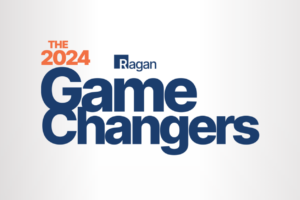What’s broken in internal comms?
Some answers emerged in a survey of frontline workers: Communicate more and more often, be transparent, and prioritize managerial communication.

We conducted a survey of 1,000 frontline workers to learn what they think of the communication they receive. The survey covered topics they want to hear more about, satisfaction with the amount of comms they receive, engagement, levels of trust, etc. While the results skewed more positive than we anticipated, one question was particularly eye-opening: “What’s one thing that could be improved about communication at your organization (from corporate or your manager)?”
The results
We tagged all 1,000 answers with a theme(s) to see what trends emerged. While there were many responses that were unique, many people were on the same page about a lot of topics. Some weren’t surprising, but others hit home about how tough it is out there on the frontline:
- The need for more positive comms, reporting that everything they received felt negative.
- Increased responsiveness. Some said they were ignored altogether when they had questions.
- Addressing the lack of respect when they were communicated to.
While these cases were somewhat rare, even 1% of your employees feeling disrespected is too many. The reality is, the employee experience is far from standardized. The frontline experience can widely vary.
Major themes
Although there were a lot of important trends from the survey, we’re going to focus on the top four.
1. More communication
While some respondents said they wanted less communication, far more reported wanting more. Some individuals cited the specific topic(s) that they thought needed more attention, including benefits, training, general safety, and the state of the business.
- “That they would actually communicate so that I could do my job accordingly. Things that I have to know to do my job are often not communicated to me as they should be.”
- “More communication about the future of our company and what direction its heading in”
Although 67% reported being satisfied or extremely satisfied with communication, those that aren’t satisfied … really aren’t. The lack of communication isn’t just a frustration, it prevents people from doing their jobs.
2. More timely communication
The second biggest trend was the timeliness of communication. It was clear that this was a big point of frustration:
- “Timeliness of communication. My employer has been notorious for delivering important information at the last minute before some major changes have taken place.”
- “For [comms] to be more proactive instead at the last minute when things need to be completed.”
Internal communicators try their best to get communication out as fast as possible. But sometimes messages get caught up in the approval process. Sometimes we have to rely on the cascade of communication, which takes time.
3. More transparency
Without transparency, it’s hard to build trust. The third biggest trend was wanting to be kept in the loop and trusted with information. Not surprisingly, many of the responses also allude to a lack of trust:
- “I have trouble believing anything they say and not everyone is privileged to all the information”
- “Just be honest, we know not all the answers are known but we still want to be kept in the loop”
4. More face-to-face or 1:1 communication
There was also a clear need for more one-on-one meetings with their manager and wanting more face-to-face communication in general.
- “I’d like to be able to have more time to speak with them face to face, there’s several things I need to discuss with them, but they never want to take the time to dive into it.”
- “That they actually talk to you face to face. There’s always a miscommunication in text and email, due to wording and phrases and they always sound like jerks”
So … what’s broken in IC?
Despite a majority feeling positively about communication, it’s not a vast majority. We worry that some might think, “This is as good as it gets” or, “This is just how it is in my industry”—and sentiments like this did pop up. It’s clear from the written responses—at least 60% having something constructive, if not negative, to say—indicates that something is seriously broken with the way we communicate. It’s a few key things:
We aren’t focusing enough on manager communication.
Even though we know that managers are a top reason why people quit and account for 70% of the variance in employee engagement (Gallup), we don’t prioritize this enough. Give line managers talking points and train them on how to be better communicators.
We are waiting too long to communicate.
Many employees aren’t receiving the information they need when they need it—and that’s the name of the game in communications. Whether you’re waiting too long on approvals, don’t have the right channels, or are waiting to have all the answers first, something has to change. Employees may largely trust their organizations right now (Edelman), but how long will that last if we keep them in the dark?
We need to dig deeper when we survey frontline teams.
If we had just sent out our survey without this write-in question, we might have assumed that everything was going well. But the reality is, there is still a lot of work to be done. The only way to figure out what’s broken at your company, is to ask.
You can get all the results from theEMPLOYEEapp’s survey for free by downloading our State of Frontline Worker Communication Report. This article is in partnership with theEMPLOYEEapp.
Amy Jenkins has spent over a decade working in internal communication and is now the director of client success and strategy at theEMPLOYEEapp.







Amy,
I am doing an ongoing change/crisis communications campaign for an Albemarle global business and have both scheduled meetings and random Pulse surveys that follow.
Communicating and surveying a 1,500-member global employee base serving customers in 120 companies requires a nimble approach with leadership buy-in and responsive employee engagement. For example, our survey respondents totaled 30.2 percent – valid statistically – with some 500 comments that are reviewed by the CEO and the leadership team weekly.
You did not address the importance of in-language team meetings globally or a solution to engaging managers – we call them Manager Moments that go from the CEO to the management team each month. A great tool that has its genesis in GE as part of my career path.
We are succeeding with our internal comms with a regular rhythm, measured engagement and empathy for a global team that shares the desire to succeed and a shared goal of going to work, coming home and supporting families. And we have much more work to do.